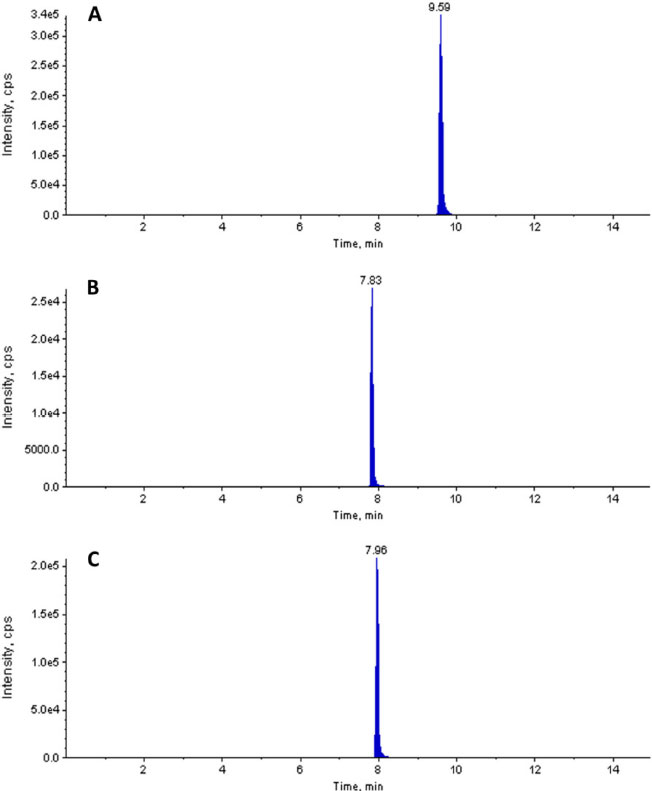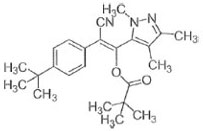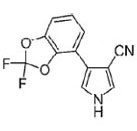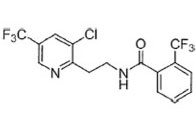
풋고추와 꽈리고추 중 cyenopyrafen, fludioxonil 및 fluopyram의 잔류특성
초록
이 연구는 풋고추와 꽈리고추의 과종 간 형태적 특성에 따른 경시적 잔류 특성을 구명하기 위해 수행되었다. 시험농약은 cyenopyrafen, fludioxonil 및 fluopyram이었으며 각 농약의 안전사용기준에 따라 cyenopyrafen과 fludioxonil의 경우 7일 간격으로 2회, fluopyram의 경우 7일 간격으로 3회 살포하였다. 시료는 최종 약제 처리 후 0, 3, 5, 7 및 10일차에 수확하였다. 경시적 잔류량 감소 양상을 분석하기 위해서 일원배치 분산분석과 duncan의 다중검정으로 유의성을 검증하고 풋고추와 꽈리고추의 과종 간 잔류량 비교를 위하여 독립표본 t-검정을 실시하였다(p<0.05). 풋고추와 꽈리고추에 대한 회수율은 cyenopyrafen의 경우 각각 83.1-103.5%, 69.0-108.6%로 나타났다. Fludioxonil은 각각 98.3-109.5%, 107.7-115.3%로 나타났으며 fluopyram은 각각 87.8-101.8%, 101.9-107.7%로 나타났다. 풋고추와 꽈리고추에서 cyenopyrafen, fludioxonil 및 fluopyram의 잔류량은 시간이 지남에 따라 유의적으로 감소하는 양상을 나타내었으며(p<0.05) 모든 일자에서 국내 MRL 기준인 3mg/kg 이하로 나타났다. Cyenopyrafen과 fludioxonil의 경우 안전사용기준의 수확 예정일인 약제 살포 후 3일차에서 풋고추와 꽈리고추간 잔류량의 유의한 차이를 보였다. 그러나 대부분의 수확 일자에서 풋고추와 꽈리고추의 품종 간 잔류량의 유의한 차이가 없었으므로 수확일자별 잔류량은 모두 잔류허용기준 미만이었으므로 풋고추의 안전사용기준을 꽈리고추에 적용하여도 문제가 없을 것으로 판단되었다.
Abstract
This study was conducted as an effort to examine the residual characteristics of green chilli pepper and twisted pepper, which differ in shape. Cyenopyrafen, fludioxonil, and fluopyram were used as test pesticides in the study. Spraying of cyenopyrafen and fludioxonil was performed twice at seven-day intervals and spraying of fluopyram was performed three times at seven-day intervals according to the pre-harvest interval (PHI). The samples were harvested at 0, 3, 5, 7, and 10 days after the last application of test pesticides. The residual amount showed a tendency to dissipate over time, which was verified using one-way ANOVA and Duncan's multiple range test. The independent sample t-test was performed for comparison of residues between green chilli pepper and twisted pepper (p<0.05). The results for recovery of cyenopyrafen, fludioxonil, and fluopyram in green chilli pepper were 83.1-103.5%, 98.3-109.5%, and 87.8-101.8%, and those for recovery in twisted pepper were 69.0-108.6%, 107.7-115.3%, and 101.9-107.7%, respectively. The residual amounts of cyenopyrafen, fludioxonil, and fluopyram detected in green chilli pepper and twisted pepper showed a significant decrease over time (p<0.05) and were all below the maximum residue limit (MRL) of 3 mg/kg. A significant difference in the residues of cyenopyrafen and fludioxonil was observed between green chilli pepper and twisted pepper at three days after the last application, which is the expected harvest day according to the PHI, however, no significant difference was observed on most harvest days, and the residues detected on each harvest day were all below the MRL. Therefore, application of the PHI of cyenopyrafen, fludioxonil, and fluopyram for green chilli pepper to twisted pepper could be considered.
Keywords:
Cyenopyrafen, Fludioxonil, Fluopyram, Pepper, Pesticide residue키워드:
고추, 잔류농약서 론
농약은 작물의 병해충을 방제하여 상품성과 수확량을 증가시키고 노동력과 생산비를 절감시키기 위한 농자재로서 현대 농업에서 필수적으로 사용된다(Jang et al., 2011; Bajwa and Sandhu, 2014; Boroduleva et al., 2018). 그러나 사용된 농약은 인간에게 위해한 독성을 가지며 작물이나 토양에 잔류하게 된다(Lee et al., 2009a). 적용 작물에 적정량이 살포될 수 있도록 작물 잔류성, 독성, 약효 및 약해 시험 등을 통해 작성된 자료를 바탕으로(Kim et al., 2006) 수확 전 사용일 및 사용 횟수 등의 안전사용기준과(PSIS, 2023) 작물별 농약의 잔류허용기준(Maximum Residue Limit, MRL)이 설정되어 있다(MFDS, 2023). 농약의 MRL 설정과 안전성 평가 등에 관련한 업무는 전 세계적으로 국가 기관에서 관리하는 것으로 알려져 있으며 안전한 식품의 소비가 증가함에 따라 각 국가에서는 식품 중 농약의 안전관리제도를 강화하고 있는 추세이다(Park et al., 2005; Kim et al., 2010).
고추(Capsicum annuum L.)는 국내에서 조미채소로 분류되며 고추 생산량은 215,050톤으로 전체 채소 생산량(과채류, 엽채류, 근채류, 조미채소) 7,871,380톤 중 약 2.7%를 차지한다(KOSIS, 2022). 고추는 용도에 따라 크게 생과로 섭취하는 풋고추와 고춧가루로 가공하여 향신료로 쓰이는 홍고추로 나눌 수 있으며(Kim et al., 2020), 과형에 따라 녹광형, 청양형, 꽈리형, 오이형 및 할라페뇨형로 나뉘는데 녹광형 고추는 표면의 광택이 좋고 매끈하며 과형의 변화가 적은 반면 꽈리형 고추는 과실 표면에 굴곡이 많은 형태를 가진다(Hur, 2020).
작물에 살포된 농약은 이화학적 특성 및 살포 조건, 환경조건에 의해 잔류량과 잔류기간이 달라질 수 있으며(Choi et al., 2009; Lee, 2010) 작물체 표면의 굴곡, 과실의 증체율 및 표면적비 등의 형태적 특성 역시 잔류량에 영향을 미치는 요인이기 때문에(Lee et al., 2004, Jin et al., 2018) 표면이 매끈한 풋고추보다 표면에 굴곡이 많은 꽈리고추에서 농약 잔류량이 더 많을 가능성이 있다. 하지만 국내에서는 일반적으로 많이 재배되는 풋고추의 잔류시험 결과를 바탕으로 꽈리고추를 포함한 모든 고추를 대상으로 농약의 안전사용기준과 잔류허용기준을 설정하고 있는 실정이다(Lee et al., 2005; Food Safety Korea, 2023).
고추에서 발생하는 병해충 중 차먼지응애는 다양한 시설원예작물에서 열매의 기형 또는 표면의 코르크화를 야기하여 상품성과 수확량을 감소시키며(Cho et al., 1996) 잿빛곰팡이병은 고온다습한 시설환경에서 광범위하게 발생하며 생육기간 동안 과육을 부패시킨다(Yang et al., 2023). 본 연구는 고추의 생산단계에서 사용량이 많은 농약 중 차먼지응애를 방제하는 살충제인 cyenopyrafen과 잿빛곰팡이를 방제하는 살균제인 fludioxonil 및 fluopyram을 대상으로 풋고추와 꽈리고추 중 농약의 잔류특성을 구명하기 위해 수행되었다.
재료 및 방법
시험작물 및 농약
시험작물은 풋고추(녹광), 꽈리고추(농우꽈리풋)였으며 시험농약은 cyenopyrafen 25% 액상수화제(Suspension concentrate, SC), fludioxonil 20% 액상수화제 및 fluopyram 40% 액상수화제를 사용하였다. 시험농약의 제품명은 각각 ㈜한국삼공의 쇼크, ㈜신젠타코리아의 사파이어, ㈜바이엘크롭사이언스의 머큐리였다.
포장시험
본 시험은 경상남도 산청군 단성면에 위치한 시설하우스에서 수행하였다. 처리구는 풋고추와 꽈리고추 각각 3반복으로 배치하였다. 각 반복구 면적은 0.6m× 8m이었으며 재식간격은 0.4 m이었다.
시험 농약은 배부식 충전분무기 HP2010 (HANIL SP. CO., LTD, Geumsan-gun, Korea)를 사용하여 안전사용기준에 따라 살포하였다. Cyenopyrafen 25% 액상수화제 및 fludioxonil 20% 액상수화제는 2000배 희석하여 2023년 7월 10일에 1차 살포 후 7일 간격으로 총 2회 살포하였고 fluopyram 40% 액상수화제는 4000배 희석하여 2023년 7월 3일에 1차 살포 후 7일 간격으로 총 3회 살포하였다(Table 1). 각 시험농약의 물리화학적 특성과 살포량은 각각 Table 2 (Turner, 2021; PPDB, 2023), Table 3에 제시하였다.
시료는 농약의 경시적 잔류량 변화를 조사하기 위해 최종 약제 살포 후 0 (3시간 후), 3, 5, 7 및 10일차에 1 kg 이상 무작위로 수확하였다. 수확한 시료는 즉시 실험실로 옮겨 개체 무게를 측정한 후 드라이아이스와 함께 마쇄하여 균질화하였다. 균질화한 시료는 분석 전까지 -20oC 냉동고에 보관하였다.
시약 및 기구
Cyenopyrafen (1000 μg/ml)의 표준품은 AccuStandard (New Haven, USA)에서 구매하였고 fludioxonil (Purity 99.5%)은 신젠타 코리아 (Iksan, Korea)에서 분양받아 사용하였다. fluopyram (Purity 99.8%)은 Dr. Ehrenstofer GmbH (Augsburg, Germany)에서 구입하였다. Merck KGaA (Damstadt, Germany)의 acetone (for gas chromatography ECD and FID)과 Supelco® (Merck KGaA, Damstadt, Germany)의 acetonitrile (gradient grade for liquid chromatography), methanol (for liquid chromatography) 및 formic acid (98-100%)를 사용하였다. distilled water는 Wasserlab (Navarre, Spain)의 초순수제조장치를 이용하여 조제하였다. QuEChERS Extraction Packet (EN Method) 및 dispersicve SPE는 Agilent Technoligies (California, United States)의 제품을 사용하였다. Collomix (Gaimersheim, Germany)의 VIBA X.30을 사용하여 진탕하였으며 50 mL conical tube 및 2ml dispersicve SPE의 원심분리는 각각 Hanil Scientific Inc. (Gimpo, Korea)의 Combi-514R와 M15S-md를 사용하였다.
표준용액 조제
Fludioxonil 및 Fluopyram의 표준품을 각각 10.05mg, 10.02 mg 칭량하여 10ml의 Acetone으로 용해하여 1,000mg/L 농도의 Stock solution을 조제하였다. Working solution은 앞서 조제한 두 농약의 Stock solution과 Cyenopyrafen (1000 μg/ml)을 혼합하여 10mg/L를 조제하고 acetonitrile로 희석하여 0.025, 0.05, 0.1, 0.2, 0.5 및 1mg/L의 농도로 준비하였다. 또한 풋고추와 꽈리고추 무처리 시료의 추출액을 첨가하여 0.005, 0.01, 0.02, 0.04, 0.1 및 0.2mg/L의 matrix-matched standard를 조제하였다. 각 표준품의 chromatogram과 retention time은 Fig. 1에 제시하였다.
잔류농약 분석
풋고추와 꽈리고추를 균질화한 후 시료 10 g을 50mL conical tube에 칭량하고 acetonitrile 10 mL을 첨가한 후 2분간 진탕하였다. QuEChERS (Quick, Easy, Cheap, Effective, Rugged, Safe) EN Extraction Packets (Sodium Chloride 1.0 g, Magnesium Sulfate 4.0 g, sodium Citrate 1.0 g, Sodium Hydrogencitrate Sesquihydrate 0.5 g)을 첨가하고 2분간 진탕 후 4oC에서 3,500 rpm으로 5분간 원심 분리하였다. 추출된 상등액은 PSA (primary secondary amine) 25.0 mg, Bulk Carbograph 2.5 mg 및 magnesium Sulfate 150.0 mg가 들어있는 d-SPE tube에 1ml 첨가하고 30초간 교반 후 4oC에서 12,000 rpm으로 5분간 원심 분리하였다. 최종 추출된 상등액은 syringe filter (PTFE, 13mm, 0.22 μm)로 여과 후 200 μg을 취해 acetonitrile 50 μg를 첨가하고 matrix matching하여 Table 4에 제시한 LC-MS/MS와 MRM 조건으로 분석하였다.
분석법 검증
Cyenopyrafen, fludioxonil 및 fluopyram의 분석법 검증은 FAO에서 제시하는 가이드라인 및 농촌진흥청고시 제2023-25호를 참고하여 수행하였다(FAO, 2017; Rural Development Administration, 2023). 검량선의 결정계수(Coefficient of determination, R2)를 통해 직선성(Linearity)을 확인하고 검출한계(limit of detection, LOD), 정량한계(limit of quantitation, LOQ) 및 회수율시험(Recovery test)을 수행하였다. 검출한계와 정량한계는 신호 대 잡음비(S/N ratio)가 각각 3배 및 10 이상인 값으로 유효성을 검증하였다. 회수율 시험은 LOQ, LOQ의 10배 수준 및 LOQ의 20배 수준에서 시험농약의 표준용액을 무처리 시료에 처리하였으며 5반복 수행하였다.
저장안정성
0일차 시료 채취일 당일에 균질화된 무처리시료 10 g에 정량한계(0.01 mg/L)의 10배인 0.1mg/L 수준이 되도록 working solution 10 mg/L를 3반복 처리하고 분석용 시료와 동일하게 -20oC에서 냉동 보관하여 저장안정성 분석을 수행하였다.
비표면적 측정
풋고추와 꽈리고추의 형태적 특성에 따른 농약 잔류량을 구명하기 위해 풋고추와 꽈리고추를 각각 25개씩 수확하여 3D 스캐너인 FARO EDGE ScanArm HD (FARO, Orlando, US)를 사용하여 560,000 point/sec의 스캔 속도로 표면적을 측정하였으며 표면적 값(cm2)을 개체의 질량(g)으로 나누어 비표면적 값(cm2/g)을 산출하였다.
희석효과분석
고추의 수확 일자별 무게 변화를 고려하여 시료의 증체에 의한 농약의 희석효과를 적용한 잔류량(A)과 희석효과를 제외한 농약의 순수한 잔류량(B)은 아래의 식을 이용하여 산출하였다(Choung et al., 2016).
통계분석
풋고추와 꽈리고추 중 cyenopyrafen, fludioxonil 및 fluopyram의 경시적 잔류량과 중량 변화를 비교하기 위하여 SPSS Statistics (ver. 28, IBM Corporation, Armonk, US) 소프트웨어를 사용하여 일원배치 분산분석 (one-way analysis of variance, ANOVA)을 수행하고 Duncan의 다중검정(Duncan’s multiple range test, DMTR)으로 유의성을 검증하였다. 또한 독립표본 t-검정을 통해 풋고추와 꽈리고추 간 잔류량 차이를 분석하였다. 유의성을 위한 유의확률은 0.05로 고려하여 분석하였다.
결과 및 고찰
분석법 검증
0.005, 0.01, 0.02, 0.04, 0.1 및 0.2mg/kg의 matrix-matched standard를 조제하여 chromatogram상의 peak 면적을 기준으로 작성된 검량선의 상관계수(R2)는 모두 0.99 이상으로 직선성을 나타내었다(Table 5).
각 농약의 검출한계(LOD)는 0.025 mg/kg, 정량한계(LOQ)는 0.01 mg/kg이었다. 회수율시험은 LOQ, LOQ의 10배 및 LOQ의 20배 수준에서 수행하였으며 cyenopyrafen의 경우 풋고추와 꽈리고추의 회수율은 각각 83.1-103.5%, 69.0-108.6%로 나타났다. fludioxonil의 경우 각각 98.3-109.5%, 107.7-115.3%로 나타났으며 fluopyram의 경우 87.8-101.8%, 101.9-107.7%로 나타났다. RSD는 모두 10% 이하로 나타났으며 해당 농약 모두 첨가농도별 유효 회수율 범위인 60-120%를 만족하였다(FAO, 2016)(Table 6).
저장안정성
저장안정성 시험을 위한 시료는 81-90일 동안 저장 후 분석하였다. cyenopyrafen의 경우 회수율이 풋고추와 꽈리고추에서 각각 101.8 ± 2.40%, 109.9 ± 1.39%로 나타났다. fludioxonil의 경우 각각 101.6 ± 0.76%, 100.3 ± 2.41%로 나타났으며 fluopyram의 경우 각각 95.2 ± 3.35%, 96.7 ± 2.35%로 나타났다(Table 7). RSD는 모두 5% 이하로 나타났으며 해당 농약 모두 회수율 인정 범위인 70-120%를 만족하여 저장기간 중 분해 및 소실 되지 않았다고 판단되었다(NIFDS, 2023).
비표면적 측정
풋고추와 꽈리고추의 평균 중량은 각각 17.23 ± 1.51 g, 8.29 ± 0.85 g으로 풋고추가 꽈리고추보다 약 2.1배 무거웠다. 표면적의 경우 각각 66.49 ± 5.52 cm2, 47.07 ± 3.65 cm2로 풋고추가 꽈리고추보다 약 1.4배 더 넓은 것으로 조사되었다. 표면적 값(cm2)을 개체의 질량(g)으로 나누어 산출한 비표면적(cm2/g)은 각각 3.87 ± 0.20 cm2/g, 5.70 ± 0.24 cm2/g으로 꽈리고추가 풋고추보다 약 1.5배 큰 것으로 나타났다(Fig. 2; Table 8).
수확일자별 고추의 잔류량 변화
농약의 경시적 잔류량 변화를 조사하기 위해 최종 약제 살포 후 0(3시간 후), 3, 5, 7 및 10일차의 잔류량을 확인하였다(Table 9). Cyenopyrafen의 잔류량은 풋고추의 경우 0일차와 10일차에 각각 1.56 mg/kg, 0.20 mg/kg이었으며 꽈리고추의 경우 0일차와 10일차에 각각 1.79 mg/kg, 0.28mg/kg이었다. Fludioxonil은 풋고추의 경우 0일차와 10일차에 각각 0.76 mg/kg, 0.40 mg/kg이었으며 꽈리고추의 경우 각각 1.88 mg/kg, 0.41 mg/kg이었다. Fluopyram은 풋고추의 경우 0일차와 10일차에 각각 2.21 mg/kg, 1.09 mg/kg이었으며 꽈리고추의 경우 각각 2.61 mg/kg, 1.46 mg/kg으로 나타나 시간이 경과함에 따라 잔류량은 감소하는 경향을 보였다(p<0.05).

Comparison of residues of pesticides between green chilli pepper and twisted pepper in time dependent manners
농약의 잔류량이 감소하는 원인 중 하나로 과실의 비대생장에 따른 희석효과가 있다(Lee et al., 2012). 오이(Choi et al., 2018), 브로콜리(Yang et al., 2020) 및 들깻잎(Park et al., 2022)과 같이 급격하게 비대생장하는 작물의 농약 잔류소실의 주요 원인은 증체로 인한 희석효과이며 증체량이 적은 방울토마토(Hur et al., 2015)와 비대생장 하지 않는 대추의 경우 증체에 의한 잔류소실은 미비했다(Jo et al., 2017). 본 시험에서 고추의 비대생장에 의한 희석효과를 확인한 결과 풋고추와 꽈리고추의 대부분 처리구에서 일자별 고추 중량의 변화가 적어 비대생장에 의한 희석효과를 볼 수 없었다(Fig. 3, 4, 5). 그러나 꽈리고추의 fludioxonil 시험구에서는 고추 중량이 증가하였는데 중량의 변화가 없던 풋고추의 잔류량 변화와 비교할시 꽈리고추에서는 비대생장으로 인한 희석효과로 인하여 잔류량 소실이 비교적 빨랐던 것으로 판단되었다. 꽈리고추의 fludioxonil 처리구를 제외한 대부분의 처리구에서는 잔류량 감소에 비대생장에 따른 희석효과보다 여름철 시설하우스에 투과되는 자외선과 고온 및 장마로 인한 습도 등과 같은 시설 내 환경적인 요인이 더 작용했을 것으로 판단된다(Lee et al., 2009b).
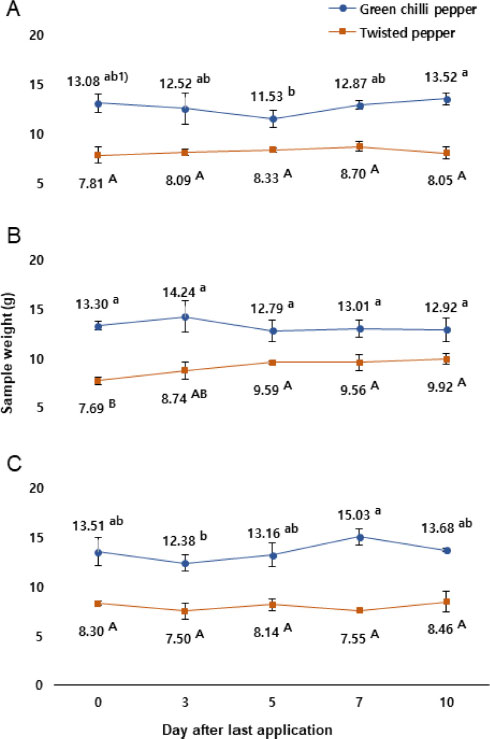
Weight of green chilli pepper and twisted pepper collected at 0, 3, 5, 7, and 10 days after last application (A: cyenopyrafen, B: fludioxonil, C: fluopyram, The different letter in the same row indicates significant difference at p < 0.05 by Duncan's multiple range test.)

Comparison of residues applying dilution effect and excluing dilution effect in green chilli pepper (A: cyenopyrafen, B: fludioxonil, C: fluopyram).

Comparison of residues applying dilution effect and excluing dilution effect in twisted pepper (A: cyenopyrafen, B: fludioxonil, C: fluopyram).
Cyenopyrafen과 fludioxonil에 비하여 fluopyram의 잔류량 변화가 더뎠는데 그 이유는 fluopyram은 침투성 농약이므로(Wang, 2013) 특성상 고추 과육에 침투하여 오랜기간 식물체 내에서 잔류할 수 있으며 토양으로 떨어진 약액이 뿌리를 통해 과육으로 이행될 가능성이 있어 다른 농약들과는 상이한 감소 양상이 나타났을 것으로 판단되었다(Bae et al., 2013). 또한 곰팡이병을 방제하는 살균제로 시설하우스 내의 높은 온도와 습도에 안정한 특성 또한 일부 영향을 끼쳤을 것으로 판단된다(Vargas-Pérez et al., 2020). 반면 cyenopyrafen및 fludioxonil은 비침투성의 특성 때문에 고추 표면에서 잔류하다가 광분해 및 휘산과 같은 온실 내 환경요인에 쉽게 노출되어 빠르게 분해되었을 것으로 사료된다(Kang et al., 2016).
고추의 품종별 잔류량 비교
작물의 비표면적은 유사작물 간 잔류량의 차이에 영향을 끼치는 주요 요인으로 완숙토마토보다 비표면적이 약 2.15배 큰 방울토마토에서 chlorothalonil, oxadixyl 및 thiophanatemethyl의 잔류량이 1.4-2.0배 높았으며(Kwon et al., 2004) 상추보다 비표면적이 2배 정도 큰 들깻잎에서 살포직후 잔류량이 1.26-2.35배 높았다(Son et al., 2012a). 또한 일반 파프리카보다 비표면적이 1.8배 더 큰 미니 파프리카에서 cyflumetofen 및 penthiopyrad의 잔류량이 1.6-2배 더 높았다는 연구결과가 있다(Shin et al., 2022). 꽈리고추는 풋고추보다 비표면적이 약 1.5배 크므로 풋고추보다 잔류량이 많을 것으로 예상하였으나 대부분의 수확일자에서 풋고추와 꽈리고추 간에 유의한 잔류량 차이는 없었다(Table 9). 다만 fludioxonil의 0, 3, 5일차에서 두 고추 간 잔류량은 유의한 차이를 보였는데 이는 최종 살포물량이 영향을 미친 것으로 판단된다. cyenopyrafen과 fluopyram은 풋고추와 꽈리고추에서 최종 살포물량이 비슷하였으며 0일차의 잔류량도 유의한 차이가 없었으나 fludioxonil의 경우 최종 살포물량이 각각 378.47 L/10a, 541.67 L/10a로 차이가 있었으며 0일차 잔류량은 각각 0.76 mg/kg, 1.88 mg/kg으로 유의한 차이를 보였다(p<0.05). 물론 다른 두 작물의 잔류량 차이를 살포물량의 차이로 판단하는 것은 부적합 할수 있으나 살포물량은 농약의 부착량과 잔류량에 영향을 미치는 요인이므로 본 실험에서도 최종 살포물량이 두 고추의 잔류량 차이에 영향을 미치는 요인이 될 수 있다고 판단하였다. 또한 0일차 잔류량 차이로 3일차와 5일차 잔류량에서도 두 고추간의 유의한 차이를 보인 것으로 판단된다. Cyenopyrafen의 경우 3일차에서만 두 고추의 잔류량에서 유의한 차이를 보였는데 꽈리고추보다 매끈한 표면을 가진 풋고추에서 비투침성인 cyenopyrafen의 초기 분해속도가 빨랐기 때문이라고 판단된다. fluopyram의 경우 10일차에서만 두 고추의 잔류량에서 유의한 차이를 보였는데 대사작용의 차이(Wei et al., 2016) 또는 연속수확 작물 특성상 열매의 시료 채취 지점에 영향을 받았을 가능성(Son et al., 2012b)이 있으나 더 정확한 원인을 파악하기 위한 연구가 필요할 것으로 보인다.
본 실험 결과 시험농약 모두 풋고추와 꽈리고추의 잔류량은 국내 안전사용기준을 포함한 모든 수확일자에서 국내 MRL(Maximum residue limit) 기준인 3mg/kg 이하로 나타났다. 비표면적이 큰 꽈리고추의 잔류량이 더 높을 것이라는 예상과 달리 대부분의 수확 일자에서 풋고추와 꽈리고추의 품종 간 잔류량의 유의한 차이가 없었으므로 풋고추로 실험하여 설정된 MRL과 농약 안전사용기준을 꽈리고추에 적용하여도 문제가 없을 것으로 판단되었다.
Acknowledgments
본 연구는 농촌진흥청 국립농업과학원 농업과학기술 연구개발사업(과제번호: PJ01509603)의 지원에 의해 수행되었으며, 이에 감사드립니다.
이해상충관계
저자는 이해상충관계가 없음을 선언합니다.
References
-
Bae CH, Cho KW, Kim YS, Park HJ, Shin KS, et al., 2013. Honeybee toxicity by residues on tomato foliage of systemic insecticides applied to the soil. Korean J. Pestic. Sci. 17(3):178-184.
[https://doi.org/10.7585/kjps.2013.17.3.178]

-
Bajwa U, Sandhu KS, 2014. Effect of handling and processing on pesticide residues in food-a review. Journal of Food Science and Technology. 51:201-220.
[https://doi.org/10.1007/s13197-011-0499-5]

-
Boroduleva AY, Manclus JJ, Montoya A, Eremin SA, 2018. Fluorescence polarization immunoassay for rapid screening of the pesticides thiabendazole and tetraconazole in wheat. Analytical and Bioanalytical Chemistry. 410:6923-6934.
[https://doi.org/10.1007/s00216-018-1296-z]

- Cho MR, Jeon HY, La SY, Kim DS, Yiem MS, 1996. Damage of broad mite, Polyphagotarsonemus latus (Banks), on pepper growth and yield and its chemical control. Korean J. Appl. Entomol. 35(4):326-331.
-
Choi JW, Kim JY, Kim HG, Leem SB, Do JA, et al., 2018. Residual properties of fluopicolide and metrafenone during cultivation of cucumber (Cucumis sativus L.). Korean J. Pestic. Sci. 22(2):91-98.
[https://doi.org/10.7585/kjps.2018.22.2.91]

-
Choi YK, Yu JH, Chun JC, 2009. Rainfastness of 5 fungicides on the leaf surface of hot pepper. J. Appl. Biol. Chem. 52(3):126-132.
[https://doi.org/10.3839/jabc.2009.022]

-
Choung MG, Ahn KG, Kim GP, Hwang YS, Kwon CH, et al., 2016. Dissipation pattern of a fungicide mandipropamid in Korean cabbage at different harvest times under greenhouse conditions. Korean J. Hortic. Sci. Technol. 34(4):644-654.
[https://doi.org/10.12972/kjhst.20160066]

- FAO, 2016. Submission and evaluation of pesticide residues data for the estimation of maximum residue levels in food and feed Pesticide Residues. FAO, Rome, Italy. Pp.27-32.
- FAO, 2017. Guidelines on performance criteria for methods of analysis for determination of pesticide residues in food and feed, CXG90-2017. FAO, Rome, Italy. p.13.
- Food Safety Korea, 2023. Application Criteria of Pesticide MRLs for agricultural commodities. https://residue.foodsafetykorea.go.kr/, (Accessed August. 2. 2023).
-
Hur KJ, Woo MJ, Kim JY, Saravanan M, Kwon CH , et a l., 2015. Establishment of pre-harvest residue limits (PHRLs) of fluopicolide and metrafenone in cherry tomato (Lycopersicon esculentum Mill.). Korean J. Environ. Agric. 34(4): 328-335.
[https://doi.org/10.5338/KJEA.2015.34.4.49]

-
Hur TW, 2020. Pepper-Agriculture technology guide 115. Rural Development Administration, Jeonju, Korea. Pp.55-56.
[https://doi.org/10.14397/jals.2021.55.6.115]

- Jang MR, Moon HK, Kim TR, Yuk DH, Kim EH, et al., 2011. The survey on pesticide residues in vegetables collected in Seoul. Korean J. Pestic. Sci. 15(2):114-124.
-
Jin MJ, Park HK, Jeong HR, Lee JW, Jo SH, et al., 2018. Residual characteristics and safety assessments of the fungicide fenhexamid in some minor crops. Korean J. Pestic. Sci. 22(4):363-369.
[https://doi.org/10.7585/kjps.2018.22.4.363]

-
Jo HW, Sohn SH, Kim KJ, Hwang GJ, Jo BH, et al., 2017. Dissipation pattern of fungicides boscalid and pyraclostrobin in Jujube. Korean J. Pestic. Sci. 21(1):17-25.
[https://doi.org/10.7585/kjps.2017.21.1.17]

-
Kang JG, Hwang JI, Lee SH, Jeon SO, Kwak SY, et al., 2016. Residual patterns of fungicides fludioxonil and metconazole in different parts of wheat. Korean J. Pestic. Sci. 20(4):341-348.
[https://doi.org/10.7585/kjps.2016.20.4.341]

- Kim KS, Kim KH, Kim NS, Ihm YB, Lee HD, et al., 2006. Survey on compliance of pesticide registration standard and pesticide usage of paddy rice and leaf vegetables in Korea. Korean J. Pestic. Sci. 10(3):183-188.
- Kim MO, Hwang HS, Lim MS, Hong JE, Kim SS, et al., 2010. Monitoring of residual pesticides in agricultural products by LC/MS/MS. Korean J. Food Sci. Technol. 42(6):664-675.
-
Kim NE, Seo DY, Cheon WY, Choi YM, Lee JS, et al., 2020. Bioactive nutritional compounds and antioxidant activity of green peppers consumed in Korea. J. Korean Soc. Food. Sci. Nutr. 49(2):141-148.
[https://doi.org/10.3746/jkfn.2020.49.2.141]

- KOSIS, 2022. Vegetable Production (Spice & Culinary Vegetables) Period Annual 1980~2022, Database Vegetable. https://kosis.kr/, (Accessed November. 17. 2023).
- Kwon HY, Kim JB, Lee HD, Ihm YB, Kyung KS, et al., 2004. Estimate of pesticide residues in tomato varieties using ratio of surface area to weight. Korean J. Pestic. Sci. 8(1):30-37.
-
Lee DY, Kim YJ, Lee SJ, Cho KS, Kim SG, et al., 2012. Establishment of pre-harvest residue limit of fungicides pyrimethanil and trifloxystrobin during cultivation of persimmon. Korean J Environ Agric. 31(1):45-51.
[https://doi.org/10.5338/KJEA.2012.31.1.45]

- Lee HD, Ihm YB, Kwon HY, Kim JB, Kyung KS, et al., 2005. Characteristics of pesticide residue in/on cucurbitaceous fruit vegetables applied with foliar spraying under greenhouse. Korean J. Pestic. Sci. 9(4):359-364.
- Lee HD, Kyung KS, Kwon HY, Ihm YB, Kim JB, et al., 2004. Residue characteristics of hexaconazole and chlorothalonil in several fruits. Korean J. Pestic. Sci. 8(2):107-111.
-
Lee HJ, Choe WJ, Lee JY, Cho DH, Kang CS, et al., 2009a. Monitoring of ergosterol biosynthesis inhibitor (EBI) pesticide residues in commercial agricultural products and risk assessment. J Korean Soc Food Sci Nutr. 38(12):1779-1784.
[https://doi.org/10.3746/jkfn.2009.38.12.1779]

-
Lee JH, Jeon YH, Shin KS, Kim HY, Park EJ, et al., 2009b. Biological half-lives of fungicides in Korean Melon under greenhouse condition. Korean J. Environ Agric. 28(4):419-426.
[https://doi.org/10.5338/KJEA.2009.28.4.419]

- Lee KS, 2010. Behavior of pesticides in soil. Korean J. Pestic. Sci. 14(3):303-317.
- MFDS, 2023. Food Code. https://various.foodsafetykorea.go.kr/fsd/#/, (Accessed November. 17. 2023).
- NIFDS, 2023. Analytical practices manual for pesticide residues in food code, 6th. National Institute of Food and Drug Safety Evaluation, O-song, Korea. Pp.221.
-
Park JU, Bae BJ, Woo SW, Jeong HJ, Jang YJ, et al., 2022. Residual characteristics and risk assessments of afidopyropen, pydiflumetofen and mefentrifluconazole in perilla leaves. Korean J. Pestic. Sci. 26(1):65-73.
[https://doi.org/10.7585/kjps.2022.26.1.65]

- Park KS, Im MH, Choi DM, Jeong JY, Chang MI, et al., 2005. Establishment of Korean maximum residue limits for pesticides in foods. Korean J. Pestic. Sci. 9(1):51-59.
- PPDB, 2023. Pesticide Properties DataBase. http://sitem.herts.ac.uk/aeru/ppdb/index.htm, (Accessed July. 14. 2023).
- PSIS, 2023. Pesticide safety information system. https://psis.rda.go.kr/psis/index.ps, (Accessed August. 2. 2023).
- Rural Development Administration, 2023. Registration standards for pesticides and raw materials. Jeonju, Korea.
-
Shin HJ, Lee RK, Kim CJ, Noh HH, Lee EY, et al., 2022. Residual characteristics of cyflumetofen and penthiopyrad in sweet pepper according to cultivar. Korean J. Pestic. Sci. 26(4):317-329.
[https://doi.org/10.7585/kjps.2022.26.4.317]

-
Son KA, Im GJ, Hong SM, Kim JB, Ihm YB, et al., 2012a. Comparison of pesticide residues in perilla leaf, lettuce and kale by morphological characteristics of plant. Korean J. Pestic. Sci. 16(4):336-342.
[https://doi.org/10.7585/kjps.2012.16.4.336]

-
Son KA, Kang TK, Park BJ, Kim TK, Gil GH, et al., 2012b. Effect of field location and spray device on pesticide residue in chilli peppers. Korean J. Pestic. Sci. 16(3):230-235.
[https://doi.org/10.7585/kjps.2012.16.3.230]

- Turner JA, 2021. The Pesticide manual Nineteenth edition. British Crop Production Council, Cambridge, UK. Pp.264- 265, Pp.525-527, Pp.547-548.
-
Vargas-Pérez M, González FJE, Frenich AG, 2020. Dissipation and residue determination of fluopyram and its metabolites in greenhouse crops. J. Sci. Food Agric. 100(13):4826-4833.
[https://doi.org/10.1002/jsfa.10542]

- Wang JH, 2013. Analytical practices manual for pesticide residues in food code, 4th. Ed. National Institute of Food and Drug Safety Evaluation, O-song, Korea. Pp.880-884, Pp.1000-1005, Pp.1011-1016.
-
Wei P, Liu Y, Li W, Qian Y, Nie Y, et al., 2016. Metabolic and dynamic profiling for risk assessment of fluopyram, a typical phenylamide fungicide widely applied in vegetable ecosystem. Scientific Reports 6:33898.
[https://doi.org/10.1038/srep33898]

-
Yang L, Liu W, Lu H, Zhang C, Chen J, et al., 2023. Cinnamaldehyde inhibits postharvest gray mold on pepper fruits via inhibiting fungal growth and triggering fruit defense. Foods 12(18):3458.
[https://doi.org/10.3390/foods12183458]

-
Yang SH, Lee JI, Choi H, 2020. Residue dissipation patterns of indoxacarb and pymetrozine in broccoli under greenhouse conditions. Korean J. Environ. Agric. 39(1):75-82.
[https://doi.org/10.5338/KJEA.2020.39.1.10]

Juryeong Lee, Residual Agrochemical Assessment Division, National Institute of Agricultural Sciences, Rural Development Administration, Researcher, http://orcid.org/0009-0007-6878-6926
Danbi Kim, Residual Agrochemical Assessment Division, National Institute of Agricultural Sciences, Rural Development Administration, Researcher, http://orcid.org/0000-0002-8819-3235
Jeong Yoon Choi, Residual Agrochemical Assessment Division, National Institute of Agricultural Sciences, Rural Development Administration, Postdoctoral researcher, http://orcid.org/0000-0002-7931-6408
Haeri Han, Residual Agrochemical Assessment Division, National Institute of Agricultural Sciences, Rural Development Administration, Researcher, http://orcid.org/0009-0003-8469-8847
Hyeyoung Kwon, Residual Agrochemical Assessment Division, National Institute of Agricultural Sciences, Rural Development Administration, Researcher, http://orcid.org/0000-0003-1361-088X
Sung Eun Park, Residual Agrochemical Assessment Division, National Institute of Agricultural Sciences, Rural Development Administration, Researcher, http://orcid.org/0009-0007-5727-2030
Conceptualization, Danbi Kim; consultation, Hyeyoung K won and Sung E un Park; f ield t rials, D anbi K im a nd Juryeong Lee and Haeri Han; formal analysis, Danbi Kim and Juryeong Lee and Jeong Yoon Choi; writing-original draft, Juryeong Lee; writing-review & editing, Juryeong Lee and Danbi Kim; resources, Danbi Kim; project administration, Danbi Kim.

